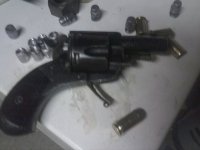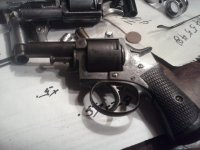easy .44 Bulldog Reloads
Been experimenting for the last few months on reloading ammo of my Belgian made .44 "British" Bulldog, probably at least 125 years old....my first experiment involved cut down .444 Marlin brass....it fits, with a slight thinning of the base, but the casing is so thick, you could probably only load a .38 caliber, bullet, so I made some blanks using .6 to .9 grams of Dupont Rifle Powder. My second experiment involved cut down .44 special cartridges, using my tubing cutter, cut the cartridges to the appropriated length and discarded the smokeless powder. According to Wikipedia, an appropriate load of black powder would be equal to .97 grams. Round balls from my cap and ball .44 Remington replica could not be seated with a .9 gram powder charge, so I made three rounds with .6, .7, and .8 grams of Dupont rifle powder. In order to seat the balls, I reamed the rims slightly with a tapered steel rod that just happened to be the right size and pressed the balls in using my drill press vise, protecting the primer with a washer in the vice. The results were quite impressive. At a distance of 15 feet or there abouts the ball from each cartridge completely penetrated a piece of 3/4 inch wafer board and produced lots of lovely smoke. Future experiments will include cutting my .44 special brass to a slightly longer length to facilitate a full load of black powder, and also the use of 180 grain conical bullets produced by the Buffalo Bullet Company, specifically designed for my .44 Colt and Remington replicas. Also, I think a slight thinning of the base just enough to remove .44 Special is justified. there is a slight clearance problem I ran into today at the range, similar to what I found originally using .444 Marlin brass, easily remidied by placing the brass on an appropriately sized dowel in a drill press and turning it on medium grit sand paper or emery cloth. by the way used the same drill press vise to seat primers...worked great. I may also try finer grained pistol black powder and Pyrodex....but I like the smoke and safety margin the rifle powder provides
Been experimenting for the last few months on reloading ammo of my Belgian made .44 "British" Bulldog, probably at least 125 years old....my first experiment involved cut down .444 Marlin brass....it fits, with a slight thinning of the base, but the casing is so thick, you could probably only load a .38 caliber, bullet, so I made some blanks using .6 to .9 grams of Dupont Rifle Powder. My second experiment involved cut down .44 special cartridges, using my tubing cutter, cut the cartridges to the appropriated length and discarded the smokeless powder. According to Wikipedia, an appropriate load of black powder would be equal to .97 grams. Round balls from my cap and ball .44 Remington replica could not be seated with a .9 gram powder charge, so I made three rounds with .6, .7, and .8 grams of Dupont rifle powder. In order to seat the balls, I reamed the rims slightly with a tapered steel rod that just happened to be the right size and pressed the balls in using my drill press vise, protecting the primer with a washer in the vice. The results were quite impressive. At a distance of 15 feet or there abouts the ball from each cartridge completely penetrated a piece of 3/4 inch wafer board and produced lots of lovely smoke. Future experiments will include cutting my .44 special brass to a slightly longer length to facilitate a full load of black powder, and also the use of 180 grain conical bullets produced by the Buffalo Bullet Company, specifically designed for my .44 Colt and Remington replicas. Also, I think a slight thinning of the base just enough to remove .44 Special is justified. there is a slight clearance problem I ran into today at the range, similar to what I found originally using .444 Marlin brass, easily remidied by placing the brass on an appropriately sized dowel in a drill press and turning it on medium grit sand paper or emery cloth. by the way used the same drill press vise to seat primers...worked great. I may also try finer grained pistol black powder and Pyrodex....but I like the smoke and safety margin the rifle powder provides


